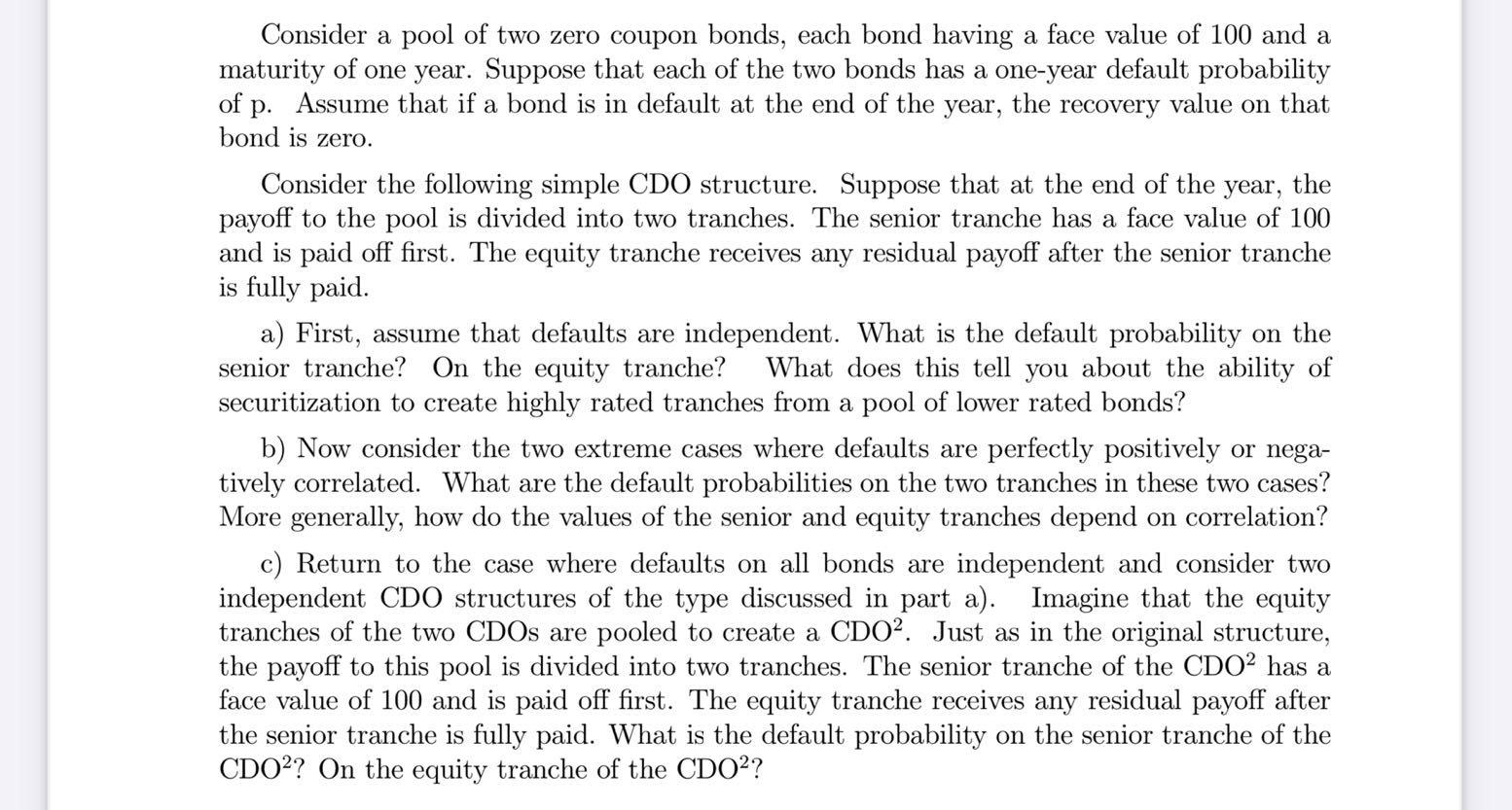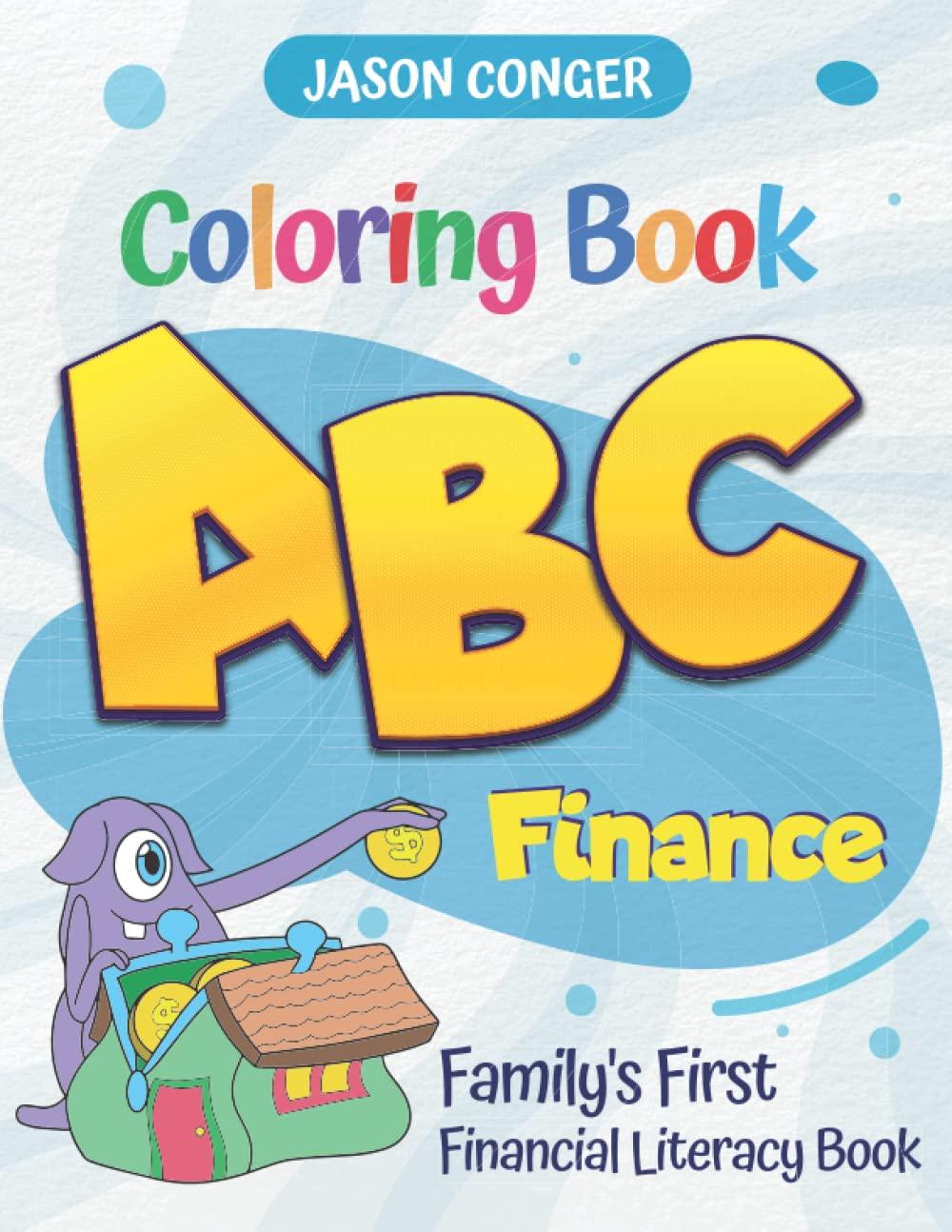Answered step by step
Verified Expert Solution
Question
1 Approved Answer
Consider a pool of two zero coupon bonds, each bond having a face value of 100 and a maturity of one year. Suppose that each
 Consider a pool of two zero coupon bonds, each bond having a face value of 100 and a maturity of one year. Suppose that each of the two bonds has a one-year default probability of p. Assume that if a bond is in default at the end of the year, the recovery value on that bond is zero. Consider the following simple CDO structure. Suppose that at the end of the year, the payoff to the pool is divided into two tranches. The senior tranche has a face value of 100 and is paid off first. The equity tranche receives any residual payoff after the senior tranche is fully paid. a) First, assume that defaults are independent. What is the default probability on the senior tranche? On the equity tranche? What does this tell you about the ability of securitization to create highly rated tranches from a pool of lower rated bonds? b) Now consider the two extreme cases where defaults are perfectly positively or negatively correlated. What are the default probabilities on the two tranches in these two cases? More generally, how do the values of the senior and equity tranches depend on correlation? c) Return to the case where defaults on all bonds are independent and consider two independent CDO structures of the type discussed in part a). Imagine that the equity tranches of the two CDOs are pooled to create a CDO2. Just as in the original structure, the payoff to this pool is divided into two tranches. The senior tranche of the CDO2 has a face value of 100 and is paid off first. The equity tranche receives any residual payoff after the senior tranche is fully paid. What is the default probability on the senior tranche of the CDO2 ? On the equity tranche of the CDO2 ? Consider a pool of two zero coupon bonds, each bond having a face value of 100 and a maturity of one year. Suppose that each of the two bonds has a one-year default probability of p. Assume that if a bond is in default at the end of the year, the recovery value on that bond is zero. Consider the following simple CDO structure. Suppose that at the end of the year, the payoff to the pool is divided into two tranches. The senior tranche has a face value of 100 and is paid off first. The equity tranche receives any residual payoff after the senior tranche is fully paid. a) First, assume that defaults are independent. What is the default probability on the senior tranche? On the equity tranche? What does this tell you about the ability of securitization to create highly rated tranches from a pool of lower rated bonds? b) Now consider the two extreme cases where defaults are perfectly positively or negatively correlated. What are the default probabilities on the two tranches in these two cases? More generally, how do the values of the senior and equity tranches depend on correlation? c) Return to the case where defaults on all bonds are independent and consider two independent CDO structures of the type discussed in part a). Imagine that the equity tranches of the two CDOs are pooled to create a CDO2. Just as in the original structure, the payoff to this pool is divided into two tranches. The senior tranche of the CDO2 has a face value of 100 and is paid off first. The equity tranche receives any residual payoff after the senior tranche is fully paid. What is the default probability on the senior tranche of the CDO2 ? On the equity tranche of the CDO2
Consider a pool of two zero coupon bonds, each bond having a face value of 100 and a maturity of one year. Suppose that each of the two bonds has a one-year default probability of p. Assume that if a bond is in default at the end of the year, the recovery value on that bond is zero. Consider the following simple CDO structure. Suppose that at the end of the year, the payoff to the pool is divided into two tranches. The senior tranche has a face value of 100 and is paid off first. The equity tranche receives any residual payoff after the senior tranche is fully paid. a) First, assume that defaults are independent. What is the default probability on the senior tranche? On the equity tranche? What does this tell you about the ability of securitization to create highly rated tranches from a pool of lower rated bonds? b) Now consider the two extreme cases where defaults are perfectly positively or negatively correlated. What are the default probabilities on the two tranches in these two cases? More generally, how do the values of the senior and equity tranches depend on correlation? c) Return to the case where defaults on all bonds are independent and consider two independent CDO structures of the type discussed in part a). Imagine that the equity tranches of the two CDOs are pooled to create a CDO2. Just as in the original structure, the payoff to this pool is divided into two tranches. The senior tranche of the CDO2 has a face value of 100 and is paid off first. The equity tranche receives any residual payoff after the senior tranche is fully paid. What is the default probability on the senior tranche of the CDO2 ? On the equity tranche of the CDO2 ? Consider a pool of two zero coupon bonds, each bond having a face value of 100 and a maturity of one year. Suppose that each of the two bonds has a one-year default probability of p. Assume that if a bond is in default at the end of the year, the recovery value on that bond is zero. Consider the following simple CDO structure. Suppose that at the end of the year, the payoff to the pool is divided into two tranches. The senior tranche has a face value of 100 and is paid off first. The equity tranche receives any residual payoff after the senior tranche is fully paid. a) First, assume that defaults are independent. What is the default probability on the senior tranche? On the equity tranche? What does this tell you about the ability of securitization to create highly rated tranches from a pool of lower rated bonds? b) Now consider the two extreme cases where defaults are perfectly positively or negatively correlated. What are the default probabilities on the two tranches in these two cases? More generally, how do the values of the senior and equity tranches depend on correlation? c) Return to the case where defaults on all bonds are independent and consider two independent CDO structures of the type discussed in part a). Imagine that the equity tranches of the two CDOs are pooled to create a CDO2. Just as in the original structure, the payoff to this pool is divided into two tranches. The senior tranche of the CDO2 has a face value of 100 and is paid off first. The equity tranche receives any residual payoff after the senior tranche is fully paid. What is the default probability on the senior tranche of the CDO2 ? On the equity tranche of the CDO2 Step by Step Solution
There are 3 Steps involved in it
Step: 1

Get Instant Access to Expert-Tailored Solutions
See step-by-step solutions with expert insights and AI powered tools for academic success
Step: 2

Step: 3

Ace Your Homework with AI
Get the answers you need in no time with our AI-driven, step-by-step assistance
Get Started


